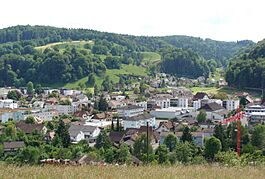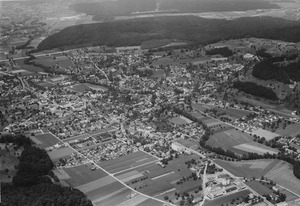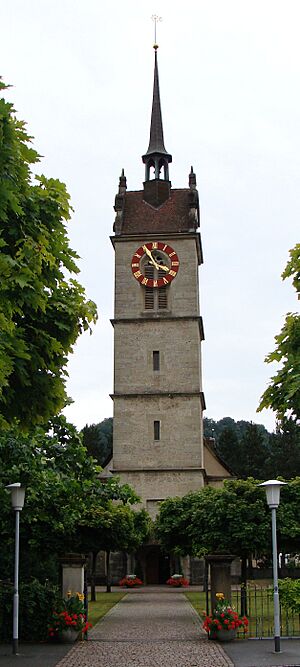Gränichen facts for kids
Quick facts for kids
Gränichen
|
||
|---|---|---|
 |
||
|
||
| Country | Switzerland | |
| Canton | Aargau | |
| District | Aarau | |
| Area | ||
| • Total | 17.23 km2 (6.65 sq mi) | |
| Elevation | 410 m (1,350 ft) | |
| Highest elevation
(Pfendel)
|
615 m (2,018 ft) | |
| Lowest elevation
(Wyna)
|
402 m (1,319 ft) | |
| Population
(Dec 2020 )
|
||
| • Total | 8,147 | |
| • Density | 472.84/km2 (1,224.6/sq mi) | |
| Postal code |
5722
|
|
| Localities | Gränichen, Rütihof, Bleien, Refental | |
| Surrounded by | Hunzenschwil, Muhen, Oberentfelden, Schafisheim, Seon, Suhr, Teufenthal, Unterkulm | |
Gränichen is a charming town, also known as a municipality, located in the Aargau canton of Switzerland. It's part of the Aarau district. This area has been settled for a very long time, with discoveries showing people lived here even in the Stone Age!
Contents
Exploring Gränichen's Geography
Gränichen is nestled in a valley where the Wyna River flows. This valley is about 500 meters (1,640 feet) wide. On both sides of the river, you'll find steep hills and smaller valleys. The landscape here looks a bit like the Tafeljura region, even though Gränichen is actually in the Midland part of Switzerland.
Hills and Hamlets
The hills on the left side of the valley include Manzenberg (524 m or 1,719 ft), Wällenen (559 m or 1,834 ft), Moosberg (550 m or 1,804 ft), Heidberg (566 m or 1,857 ft), and Pfendel (615 m or 2,018 ft). The Pfendel is the highest point in Gränichen!
On the right side of the valley, you'll find hills like Fuden (570 m or 1,870 ft), Räckholderen (566 m or 1,857 ft), Breitenberg (551 m or 1,808 ft), and Surberg (607 m or 1,991 ft).
Gränichen also includes three small villages, called hamlets, located near its southern border. These are Rütihof (585 m or 1,919 ft), Bleien (430 m or 1,411 ft), and Refental (490 m or 1,608 ft).
Land Use and Size
Gränichen covers an area of about 17.3 square kilometers (6.7 sq mi). A large part of this land, 56.7%, is covered by forests. About 30.1% is used for farming, and 13.1% has buildings or roads. The lowest point in the village is 402 meters (1,319 ft) where the Wyna River leaves the area.
Gränichen shares its borders with several other villages. These include Suhr, Hunzenschwil, Schafisheim, Seon, Teufenthal, Unterkulm, Muhen, and Hirschthal.
A Look at Gränichen's History
The first time Gränichen was mentioned in historical records was around 1184, under the name Cranechon. However, we know people lived here much earlier! Archaeologists have found things from the Neolithic period (New Stone Age). There are also remains of an old Celtic castle, showing that people have called this area home for a very long time.
In the 12th century, Gränichen was owned by the monastery of Engelberg. Later, it came under the rule of the Habsburg family. They then gave control of the village to the Lords of Liebegg Castle. After the year 1415, Gränichen became part of Bern.
A big change happened in 1904 when the Wynentalbahn railway was built. This made it easier for local businesses to grow and for more people to settle in the area.
Interesting Places to Visit in Gränichen
Gränichen has some cool historical spots that are worth seeing!
Liebegg Castle
The beautiful Liebegg Castle sits on a hill near the border with Teufenthal. It's about three kilometers (1.9 miles) south-east of the village center. This castle dates all the way back to the 11th century. Today, it's used as a place for cultural events, meetings, and conferences.
The Chornhaus
Near the village center, you'll find a building called the "Chornhaus." It was built in 1695 and looks a lot like a small castle because it has a tower! Until 1798, it was used as a granary, which is a place to store grain. After that, it became the home for the town's government for over a hundred years. Since 1995, it has been a small village museum, where you can learn about Gränichen's past.
The Reformed Church
The Reformed Church was built between 1661 and 1663. It stands on the same spot where an older church had fallen down. This church is considered one of the most important Protestant church buildings in the Aargau canton. It's even listed as a heritage site of national significance, meaning it's very important to Switzerland's history and culture.
Another important heritage site in Gränichen is the Untervogthaus on Lochgasse.
Famous People from Gränichen
- Werner Arber: A very famous microbiologist who won the Nobel Prize, was born in Gränichen in 1929.
Gränichen's Population
| Historical population | ||
|---|---|---|
| Year | Pop. | ±% |
| 1764 | 1,226 | — |
| 1803 | 1,897 | +54.7% |
| 1850 | 3,038 | +60.1% |
| 1900 | 2,771 | −8.8% |
| 1930 | 3,459 | +24.8% |
| 1950 | 3,727 | +7.7% |
| 1960 | 4,411 | +18.4% |
| 1970 | 5,298 | +20.1% |
| 1980 | 5,246 | −1.0% |
| 1990 | 5,772 | +10.0% |
| 2000 | 6,115 | +5.9% |
Gränichen has a population of 8,147. About 17.6% of the people living here are from other countries. Over the past 10 years, the town's population has grown by about 6.8%.
Most people in Gränichen speak German (90.2%). Italian is the second most common language (4.1%), followed by Albanian (1.5%).
The town has a good mix of age groups. About 9% of the population are children aged 0-9, and 12.5% are teenagers aged 10-19.
How Gränichen is Governed
Gränichen has a system to manage its town. The main law-making group is called the municipal assembly (Gemeindeversammlung). This group makes the rules for the town.
The daily running of the town is handled by the municipal council (Gemeinderat). The people on this council are chosen by the assembly and serve for four years. Their job is to lead the town, make sure the assembly's decisions are followed, and carry out tasks given by the canton and the national government.
As of January 1, 2012, the five members of the municipal council are:
- Rolf Arber, who is the Mayor
- Hans-Peter Lüem, the Vice-Mayor
- Ruedi Gautschi
- Peter Stirnemann
- Peter Hofmann
For legal matters concerning civil right, the district court of Aarau is responsible.
Economy and Jobs in Gränichen
Gränichen has a healthy economy. In 2007, the unemployment rate was quite low, at 1.54%.
Many people work in different types of jobs here:
- Primary sector: This includes jobs like farming. About 94 people work in this area.
- Secondary sector: This involves manufacturing and making things. About 1,098 people work in this sector.
- Tertiary sector: This covers service jobs, like in shops or offices. About 961 people work here.
One of the biggest bakeries in Switzerland, Jowa, is located in Gränichen. There's also a company called Zehnder that makes heaters, a gravel plant, and many other smaller businesses.
Many people who live in Gränichen travel to other towns for work. However, many people also come into Gränichen to work. This shows that Gränichen is an important place for jobs in the region.
Getting Around Gränichen
Gränichen is located on a main road that connects Aarau to Beromünster and Luzern. It's also linked to Seon in the Seetal valley.
The town has its own local train service called the AAR-Bahn. This train travels from Aarau through the Wyna valley all the way to Menziken. There are four train stations in Gränichen: Töndler, Gränichen-Dorf, Oberdorf, and Bleien. The train tracks used to be right next to the main street, but in 1985, they were moved to run along the Wyna River.
Education in Gränichen
Gränichen takes education seriously! The town has five kindergartens for younger children and three elementary schools.
For older students, there is a center for secondary education. This center offers different levels of schooling, including Realschule, Sekundarschule, and Bezirksschule. If students want to go to a gymnasium (a type of high school that prepares students for university), the closest one is in Aarau.
Besides the schools, there's also an agricultural school near Liebegg Castle.
In Switzerland, people are generally well educated. In Gränichen, about 72.7% of adults (aged 25-64) have completed either high school or even higher education, like university. In the 2008/2009 school year, there were 448 students in primary school, 203 in secondary school, and 128 students attending university-level schooling in the municipality.
Images for kids
See also
 In Spanish: Gränichen para niños
In Spanish: Gränichen para niños







